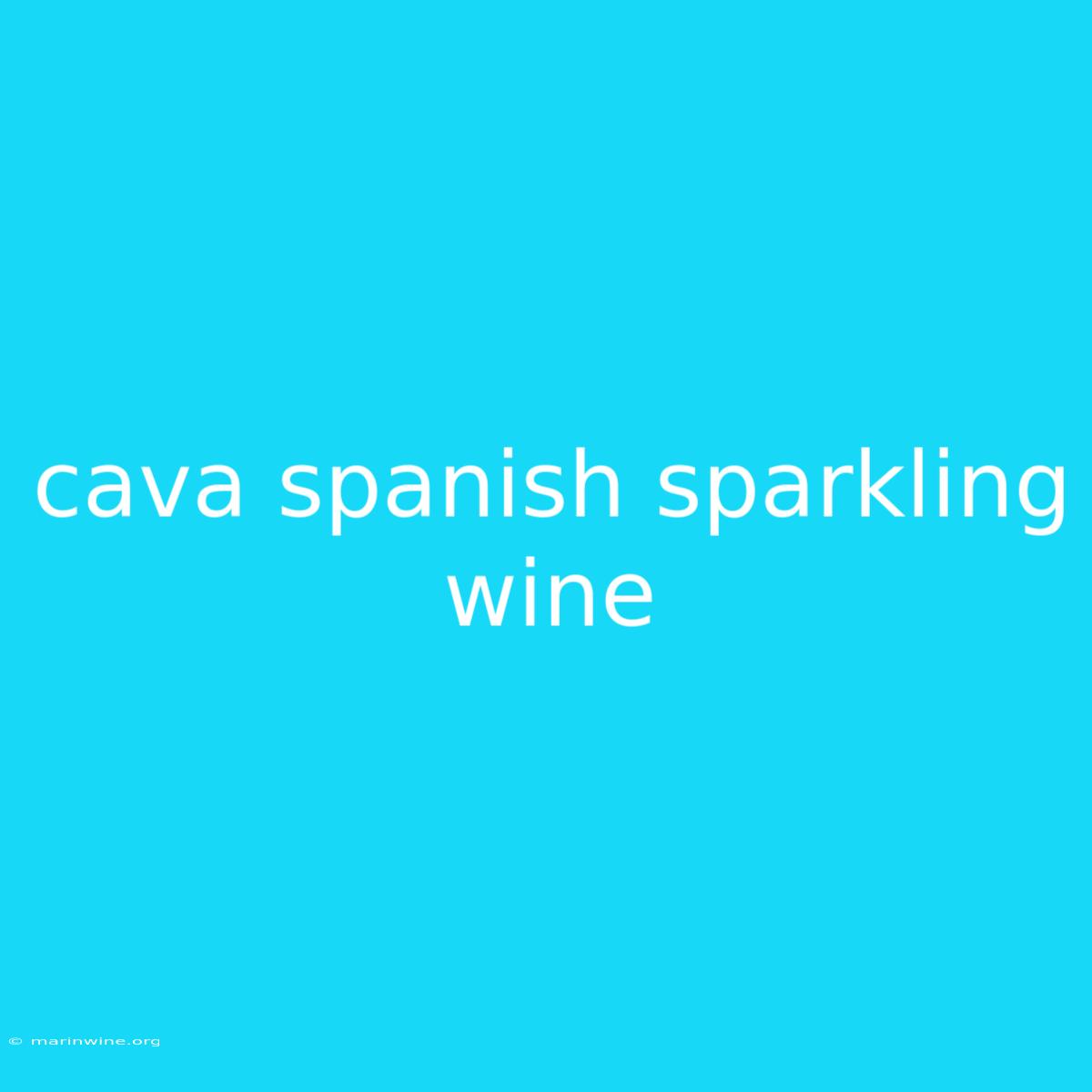Cava: The Sparkling Wine That's More Than Just Spanish Champagne
Have you ever wondered why Cava is so popular? This Spanish sparkling wine is more than just a cheaper alternative to Champagne. It's a unique product with its own history, production methods, and distinct flavor profile.
Why It Matters: Understanding the world of Cava goes beyond simply knowing it's a bubbly drink. It's about exploring the history of winemaking in Spain, appreciating the unique characteristics of this region, and discovering the diverse flavors and styles of Cava that exist. This article will delve into the key aspects of Cava production, its fascinating history, and how to enjoy this sparkling wine to the fullest.
Key Takeaways of Cava:
| Key Takeaway | Description |
|---|---|
| Made in Spain | Cava is produced exclusively in Spain, mostly in the Penedès region near Barcelona. |
| Traditional Method | Cava uses the same traditional method as Champagne, involving a second fermentation in the bottle. |
| Diverse Grape Varieties | Cava can be made from a variety of grapes, including Macabeo, Xarel-lo, and Parellada. |
| Dry to Sweet | Cava offers a range of sweetness levels, from Brut Nature (bone dry) to Semi-Seco (slightly sweet). |
| Versatile Pairing | Cava is a versatile wine that pairs well with various dishes, from tapas to seafood to desserts. |
Cava: A Sparkling Journey Through History
The story of Cava starts with the arrival of the traditional method of sparkling wine production in Spain. In the late 19th century, Catalan winemakers, inspired by the success of Champagne, began experimenting with this technique. The first Cava was produced in 1872, and by the early 20th century, the region was producing significant quantities of this sparkling wine.
Key Aspects of Cava Production
The traditional method is at the heart of Cava production. This involves a second fermentation in the bottle, where yeast converts sugar into carbon dioxide, creating the bubbles. This process takes time, with Cava often aging for at least 9 months, with some producers aging their Cava for even longer periods.
The grapes used for Cava are key to its unique flavor. While the traditional blend of Macabeo, Xarel-lo, and Parellada is most common, other authorized varieties like Chardonnay, Pinot Noir, and Garnacha are also used.
Cava comes in different styles, depending on the sugar content. The main categories include:
- Brut Nature: Bone dry, with no added sugar.
- Brut: Very dry, with a maximum of 12 grams of sugar per liter.
- Extra Brut: Dry, with a maximum of 6 grams of sugar per liter.
- Sec: Dry, with a maximum of 30 grams of sugar per liter.
- Semi-Seco: Slightly sweet, with a maximum of 50 grams of sugar per liter.
- Dulce: Sweet, with a maximum of 100 grams of sugar per liter.
The Connection Between Cava and Gastronomy
Cava's versatility makes it a perfect companion to various cuisines. It complements tapas dishes, seafood, and even rich desserts. Its refreshing acidity and delicate bubbles cleanse the palate, enhancing the flavors of the food.
Understanding Cava: An Information Table
| Feature | Description |
|---|---|
| Region of Origin | Penedès region in Catalonia, Spain |
| Production Method | Traditional Method (second fermentation in the bottle) |
| Grape Varieties | Macabeo, Xarel-lo, Parellada (traditional blend), Chardonnay, Pinot Noir, Garnacha |
| Styles | Brut Nature, Brut, Extra Brut, Sec, Semi-Seco, Dulce |
| Aging Requirements | Minimum 9 months, with some producers aging for longer periods |
| Flavor Profile | Fresh, crisp, fruity, with varying levels of sweetness |
| Pairing Suggestions | Tapas, seafood, salads, desserts |
FAQ for Cava
Q: Is Cava a good substitute for Champagne?
A: While Cava is a delicious sparkling wine, it's not a direct substitute for Champagne. They have different flavor profiles, production methods, and regulations. However, Cava is an excellent alternative offering a unique experience.
Q: How long can I keep Cava?
A: Cava can be aged for several years, but the ideal aging time depends on the specific bottle. Look for a "Best Before" date on the label.
Q: What is the difference between Cava and Prosecco?
A: Both are sparkling wines but differ in production method and flavor. Cava uses the traditional method, while Prosecco employs the Charmat method (second fermentation in tanks). Cava generally has a more complex flavor profile than Prosecco.
Q: How do I serve Cava?
A: Cava should be served chilled, between 6-8°C (43-46°F). Use a tall, slender flute glass to enhance the aroma and showcase the bubbles.
Q: What are some good Cava brands to try?
A: There are many excellent Cava brands available. Some popular options include Freixenet, Codorniu, and Juve y Camps.
Tips for Enjoying Cava
- Chill the bottle thoroughly: The ideal serving temperature is 6-8°C (43-46°F).
- Use a flute glass: This shape helps to enhance the aroma and showcase the bubbles.
- Experiment with different styles: Try Brut Nature, Brut, or even a Semi-Seco to find your preferred sweetness level.
- Pair Cava with food: It goes well with tapas, seafood, salads, and desserts.
- Enjoy Cava with friends: This festive wine is perfect for celebrations and social gatherings.
Summary of Cava
Cava is a delightful Spanish sparkling wine with a rich history, unique production methods, and a diverse range of styles. It's a refreshing and versatile beverage that can be enjoyed on its own or paired with a variety of foods. Whether you're looking for a bubbly alternative to Champagne or simply want to explore the world of sparkling wines, Cava offers a taste of Spain's sparkling heritage.
¡Salud!

